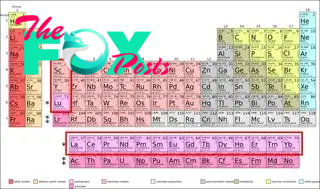Science
Mystery iron-rich magma entombed in dead volcanoes could be rich source of rare earth elements
Volcanoes that are rich in iron might be prime locations to find high concentrations of rare earth elements. Recent lab experiments have demonstrated that when iron-rich magmas experience volcanic pressures and temperatures, the resulting iron oxide-apatite (IOA) deposit separates into two unmixable melts, one of which is highly enriched in rare earth elements (REEs).
"The rare earth element contents can be close to 200 times higher than in the silicate-rich melts," said Shengchao Yan, a doctoral student at the Chinese Academy of Sciences' Institute of Geology and Geophysics and lead researcher on the new experiments.
The research, which was published in Geochemical Perspectives Letters, supports the idea that deposits of iron oxide and apatite, an iron-phosphate mineral mined globally for its iron, could be rich targets for REE exploration.
Not rare, but hard to mine
Rare earth elements, the lanthanide series as well as yttrium and scandium, are key to a green energy transition because they are required for producing electric vehicle and wind turbine magnets, solar panels, and storage batteries. With the growing need to address the climate crisis, economies around the world face an increasing demand for REEs.

But supply is hard to come by. Despite the name, REEs are not rare. These metals exist around the world but are often found in small concentrations or are locked in other minerals. This makes REE extraction economically and environmentally unsustainable for most countries. Currently, 63% of the world's REE mining occurs in China.
However, rocks enriched in REEs have been found unexpectedly at iron mines in Kiruna, Sweden; El Laco, Chile; and elsewhere. The enrichment makes those REEs easier to extract.
These mines are sited on extinct iron-rich volcanoes that have large IOA deposits.
-

 Science2d ago
Science2d agoInside Capitol Hill’s Latest UFO Hearings
-

 Science2d ago
Science2d agoYou Won’t Want to Miss the Leonid Meteor Shower. Here’s How and When You Can See It
-

 Science3d ago
Science3d agoHere’s What Trump’s Win Means for NASA
-

 Science6d ago
Science6d agoWhy Risky Wildfire Zones Have Been Increasing Around the World
-

 Science6d ago
Science6d agoIt’s Time to Redefine What a Megafire Is in the Climate Change Era
-

 Science1w ago
Science1w ago4 Astronauts Return to Earth After Being Delayed by Boeing’s Capsule Trouble and Hurricane Milton
-

 Science1w ago
Science1w agoThe Elegance and Awkwardness of NASA’s New Moon Suit, Designed by Axiom and Prada
-

 Science1w ago
Science1w agoSpaceX Launches Its Mega Starship Rocket. This Time, Mechanical Arms Catch It at Landing



























